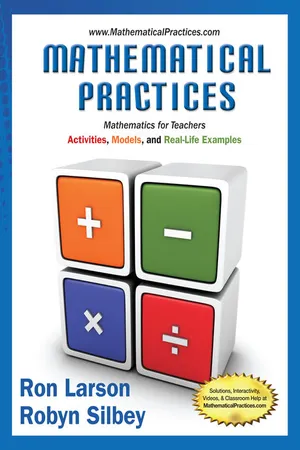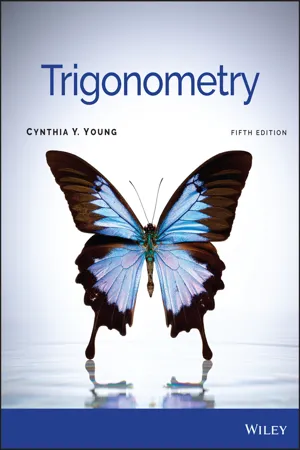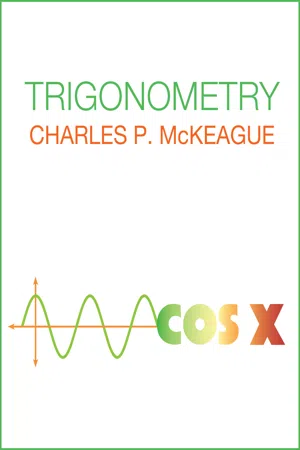Mathematics
Area of Circular Sector
The area of a circular sector is the measure of the region enclosed by the two radii and the arc of the sector. It is calculated using the formula A = (θ/360)πr², where θ is the central angle of the sector and r is the radius of the circle. This concept is important in geometry and trigonometry for calculating areas of sectors in circles.
Written by Perlego with AI-assistance
Related key terms
1 of 5
7 Key excerpts on "Area of Circular Sector"
- No longer available |Learn more
- Daniel C. Alexander, Geralyn M. Koeberlein, , , Daniel C. Alexander, Geralyn M. Koeberlein(Authors)
- 2014(Publication Date)
- Cengage Learning EMEA(Publisher)
As shown in Figure 8.47, the sector of a circle generally has the shape of a center-cut piece of pie. * Copyright 2013 Cengage Learning. All Rights Reserved. May not be copied, scanned, or duplicated, in whole or in part. Due to electronic rights, some third party content may be suppressed from the eBook and/or eChapter(s). Editorial review has deemed that any suppressed content does not materially affect the overall learning experience. Cengage Learning reserves the right to remove additional content at any time if subsequent rights restrictions require it. AREA OF A SECTOR Just as the length of an arc is part of the circle’s circumference, the area of a sector is part of the area of this circle. When fractions are illustrated by using circles, is represented by shading a 90° sector, and is represented by shading a 120° sector (see Figure 8.48). Thus, we make the following assumption about the measure of the area of a sector. 1 3 1 4 8.5 ■ More Area Relationships in the Circle 375 Unless otherwise noted, all content on this page is © Cengage Learning. The ratio of the degree measure m of the arc (or central angle) of a sector to 360° is the same as the ratio of the area of the sector to the area of the circle; that is, area of sector area of circle m 360 . POSTULATE 23 Theorem 8.5.1 follows directly from Postulate 23. EXAMPLE 1 If , find the area of the 100° sector shown in Figure 8.49. Use your calculator and round the answer to the nearest hundredth of a square inch. SOLUTION becomes In applications with circles, we often seek exact answers for circumference and area; in such cases, we simply leave in the result. For instance, in a circle of radius length 5 in., the exact circumference is 10 in. and the exact area is expressed as . Because a sector is bounded by two radii and an arc, the perimeter of a sector is the sum of the lengths of the two radii and the length of its arc. In Example 2, we use the intercepted arc and apply the formula, . - eBook - PDF
Mathematical Practices, Mathematics for Teachers
Activities, Models, and Real-Life Examples
- Ron Larson, Robyn Silbey(Authors)
- 2014(Publication Date)
- Cengage Learning EMEA(Publisher)
Area of a Sector When the central angle of the sector is aº, the area A of the sector is A = ( a — 360 ) πr 2 . EXAMPLE 8 Finding the Area of a Sector EXAMPLE 9 Finding the Area of a Composite Figure Find the area of the portion of the basketball court. 19 ft 12 ft SOLUTION The figure consists of a rectangle and a semicircle. You can find the area of the entire figure by finding the sum of the areas of these two figures. Area of rectangle Area of semicircle A = (length)(width) A = ( a — 360 ) πr 2 = (19)(12) = ( 180 — 360 ) π(6) 2 = 228 = 18π ≈ 56.52 So, the area of the portion of the basketball court is about 228 + 56.52 = 284.52 square feet. The semicircle has a radius of 12 — 2 = 6 feet. Write formula for the area of a sector. Copyright 2014 Cengage Learning. All Rights Reserved. May not be copied, scanned, or duplicated, in whole or in part. Due to electronic rights, some third party content may be suppressed from the eBook and/or eChapter(s). Editorial review has deemed that any suppressed content does not materially affect the overall learning experience. Cengage Learning reserves the right to remove additional content at any time if subsequent rights restrictions require it. 464 Chapter 12 Circles and Circular Solids 1. Writing a Solution Key Write a solution key for the activity on page 458. Describe a rubric for grading a student’s work. 2. Grading the Activity In the activity on page 458, a student gave the answers below. Each question is worth 10 points. Assign a grade to each answer. For those that are incorrect, why do you think the student erred? Sample Student Work The area of the circle is twice the square of the radius. r r 2 r 2 2 3. Finding the Diameter and the Radius of a Circle a. Find the diameter b. Find the radius of the circle. of the circle. 3 m 14 in. 4. Finding the Diameter and the Radius of a Circle a. Find the diameter b. Find the radius of the circle. of the circle. - eBook - PDF
- Daniel C. Alexander, Geralyn M. Koeberlein(Authors)
- 2019(Publication Date)
- Cengage Learning EMEA(Publisher)
Thus, we make the following assumption about the measure of the area of a sector. Figure 8.48 POSTULATE 24 The ratio of the degree measure m of the arc (or central angle) of a sector to 360° is the same as the ratio of the area of the sector to the area of the circle; that is, area of sector area of circle 5 m 360 . Theorem 8.5.1 In a circle of radius length r, the area A of a sector whose arc has degree measure m is given by A 5 m 360 pr 2 . Theorem 8.5.1 follows directly from Postulate 24. The expression for the area of this sector can be written in the form m AB C 360 pr 2 . Segment of a Circle Area and Perimeter of a Segment Area of a Triangle with an Inscribed Circle 386 CHAPTER 8 ■ AREAS OF POLYGONS AND CIRCLES EXAMPLE 1 If muni2220O 5 100uni00B0 , find the area of the 100° sector shown in Figure 8.49. Use your calculator and round the answer to the nearest hundredth of a square inch. SOLUTION A 5 m 360 pr 2 becomes A 5 100 360 # p # 10 2 < 87.27 in 2 Figure 8.49 O A B 10 in. In applications with circles, we often seek exact answers for circumference and area; in such cases, we simply leave p in the result. For instance, in a circle of radius length 5 in., the exact circumference is 10p in. and the exact area is expressed as 25p in 2 . Because a sector is bounded by two radii and an arc, the perimeter of a sector is the sum of the lengths of the two radii and the length of its arc. In Example 2, we use the intercepted arc AB C and apply the formula, P sector 5 2r 1 / AB C . EXAMPLE 2 Given that muni2220O 5 100uni00B0, find the perimeter of the sector shown in Figure 8.49. Use the calculator value of p and round your answer to the nearest hundredth of an inch. SOLUTION Because r 5 10 and muni2220O 5 100uni00B0, / AB C 5 100 360 # 2 # p # 10 < 17.45 in. Now P sector 5 2r 1 / AB C becomes P sector 5 2(10) 1 17.45 < 37.45 in. Because a semicircle is one-half of a circle, a semicircular region corresponds to a central angle of 180°. - eBook - PDF
- Cynthia Y. Young(Author)
- 2021(Publication Date)
- Wiley(Publisher)
Round the answer to three significant digits. Solution Write the formula for area of a circular sector. A = 1 __ 2 r 2 θ r Substitute r = 2.2 centimeters and θ = 25° into the formula. A = 1 __ 2 (2.2 cm ) 2 (25°) Simplify. A = 60.5 cm 2 This is incorrect. What mistake was made? Conceptual In Exercises 79–82, determine whether each statement is true or false. 79. The length of an arc with central angle 45° in a unit circle is 45. 80. The length of an arc with central angle π __ 3 in a unit circle is π __ 3 . 81. If the radius of a circle doubles, then the arc length (associated with a fixed central angle) doubles. 82. If the radius of a circle doubles, then the area of the sector (associated with a fixed central angle) doubles. 83. If a smaller gear has radius r 1 , a larger gear has radius r 2 , and the smaller gear rotates θ° 1 , what is the degree measure of the angle the larger gear rotates? 84. If a circle with radius r 1 has an arc length s 1 associated with a particular central angle, write the formula for the area of the sector of the circle formed by that central angle, in terms of the radius and arc length. Challenge For Exercises 85–88, refer to the following: You may think that a baseball field is a circular sector, but it is not. If it were, the distances from home plate to left field, center field, and right field would all be the same (the radius). Where the infield dirt meets the outfield grass and along the fence in the outfield are arc lengths associated with a circle of radius 95 feet and with a vertex located at the pitcher’s mound (not home plate). (Source: Karp, Cell and Molecular Biology, 8e, Figure 13.5, p. 517.) Infield / Outfield Grass Line: 95-ft radius from front of pitching rubber Infield Second base First base 13-ft radius Third base 13-ft radius Home plate 13-ft radius Foul line Foul line 90 ft between bases Pitching Mound 9-ft Radius 85. - eBook - PDF
- John Peterson, Robert Smith(Authors)
- 2018(Publication Date)
- Cengage Learning EMEA(Publisher)
Copyright 2019 Cengage Learning. All Rights Reserved. May not be copied, scanned, or duplicated, in whole or in part. Due to electronic rights, some third party content may be suppressed from the eBook and/or eChapter(s). Editorial review has deemed that any suppressed content does not materially affect the overall learning experience. Cengage Learning reserves the right to remove additional content at any time if subsequent rights restrictions require it. Unit 27 AREAS OF CIRCLES, SECTORS, SEGMENTS, AND ELLIPSES 697 SECTORS Determine the unknown area, radius, or central angle for each sector, 9 through 13, in Figure 27–45. Round the answers to 1 decimal place. Figure 27–45 Central Angle Area Radius 9. 10. 11. 12. 13. 5.50 in. 13.40 m 0.200 km 18 9 9.0 0 120.0 8 65 8 0 9 78 8 20 9 230 8 25 9 54.36 sq in. 0.0300 km 2 SEGMENTS Find the area of each of the segments ACB for exercises 14 through 16 in Figure 27–46. Refer to Figure 27–47. Round the answers to 1 decimal place. 14. 15. 16. 58.0 cm 2 135.3 sq yd 587.0 sq in. 72.3 cm 2 207.8 sq yd 719.5 sq in. Area of Isosceles D AOB Area of Sector OACB Area of Segment ACB Figure 27–46 A B C O Figure 27–47 ELLIPSES Find the unknown area, major axis, or minor axis of each of these ellipses, 17 through 21, in Figure 27–48. Round the answers to 1 decimal place. Figure 27–48 17. 18. 19. 20. 21. 27.00 yd 19.00 yd 7.00 m 9.60 m 54.6 cm 14 9 0.0 0 10 9 9.0 0 18.26 in. 259.7 sq in. 1720 cm 2 Major Axis Minor Axis Area Copyright 2019 Cengage Learning. All Rights Reserved. May not be copied, scanned, or duplicated, in whole or in part. Due to electronic rights, some third party content may be suppressed from the eBook and/or eChapter(s). Editorial review has deemed that any suppressed content does not materially affect the overall learning experience. Cengage Learning reserves the right to remove additional content at any time if subsequent rights restrictions require it. - eBook - PDF
- Charles P. McKeague(Author)
- 2020(Publication Date)
- XYZ Textbooks(Publisher)
s Since s = rθ , r = __ θ 230 so r = _____________ (0.45°)( π /180°) 230(180) ≈ __________ (0.45)(3.14) = 29,000 feet to the nearest thousand feet C Area of a Sector Next we want to derive the formula for the area of the sector formed by a central angle θ (Figure 7). FIGURE 7 s θ r this is called a sector 3.4 Length of an Arc and Area of a Sector 155 If we let A represent the area of the sector formed by central angle θ , we can find A by setting up a proportion as follows: We say the area A of the sector is to the area of the circle as θ is to one full rotation. That is, Area of sector A ___ πr 2 = θ ___ 2 π Central angle θ Area of circle One full rotation We solve for A by multiplying both sides of the proportion by πr 2 . πr 2 · A ___ πr 2 = θ ___ 2 π · πr 2 A = 1 __ 2 r 2 θ Example 6 Find the area of the sector formed by a central angle of 1.4 radians in a circle of radius 2.1 meters. Solution We have r = 2.1 meters and θ = 1.4. Applying the formula for A gives us A = 1 __ 2 r 2 θ = 1 __ 2 (2.1) 2 (1.4) = 3.087 meters 2 Remember Area is measured in square units. When r = 2.1 meters, r 2 = (2.1 meters) 2 = 4.41 meters 2 . Example 7 If the sector formed by a central angle of 15° has an area of _ π 2 3 centimeters , find the radius of the circle. Solution We first convert 15° to radians. θ = 15° π ___ 180° = π ___ 12 Then we substitute θ = __ π 12 and A = _ π 3 into the formula for A , and then solve for r. A = __ 2 r 2 θ π __ 3 = 1 __ 2 r 2 π ___ 12 π __ 3 = π ___ 24 r 2 r 2 = π __ 3 · 24 ___ π r 2 = 8 r = 2 √ — 2 centimeters 1 Note that we need only use the positive square root of 8, since we know our radius must be measured with positive units. 156 Chapter 3 Radian Measure Example 8 A lawn sprinkler located at the corner of a yard is set to rotate through 90° and project water out 30 feet. To three significant digits, what area of lawn is watered by the sprinkler? __ π Solution We have θ = 90° = radians, and r = 30 feet. - eBook - PDF
- Cynthia Y. Young(Author)
- 2017(Publication Date)
- Wiley(Publisher)
Approximately how much area do the first baseman and third baseman each need to cover? Round to the nearest square foot. In Exercises 73 and 74, explain the mistake that is made. • C AT C H T H E M I S TA K E 73. A circle with radius 5 centimeters has an arc that is made from a central angle with measure 65°. Approximate the arc length to the nearest millimeter. Solution: Write the formula for arc length. s 5 r u Substitute r 5 5 centimeters and u 5 65° into the formula. s 5 1 5 cm21 652 Simplify. s 5 325 cm This is incorrect. What mistake was made? 74. For a circle with radius r 5 2.2 centimeters, find the area of the circular sector with central angle measuring u 5 25°. Round the answer to three significant digits. Solution: Write the formula for area of a circular sector. A 5 1 2 r 2 u r Substitute r 5 2.2 centimeters and u 5 25° into the formula. A 5 1 2 1 2.2 cm2 2 1 25 ° 2 Simplify. A 5 60.5 cm 2 This is incorrect. What mistake was made? In the chapter opener about a 2016 Lexus RS with standard 18-inch rims, we learned that the onboard computer that determines distance (odometer reading) and speed (speedometer) combines the number of tire rotations and the size of the tire. Because the onboard computer is set for 18-inch rims (which corresponds to a tire with 30-inch diameter), if the owner decided to upgrade to 20-inch rims (corresponding to a tire with 30.2-inch diameter), the computer would have to be updated with this new information. If the computer is not updated with the new tire size, both the odometer and speedometer readings will be incorrect. You will see in this section that the angular speed (rotations of tires per second), radius (of the tires), and linear speed (speed of the automobile) are related. In the context of a circle, we will first define linear speed, then angular speed, and finally relate them using the radius.
Index pages curate the most relevant extracts from our library of academic textbooks. They’ve been created using an in-house natural language model (NLM), each adding context and meaning to key research topics.






